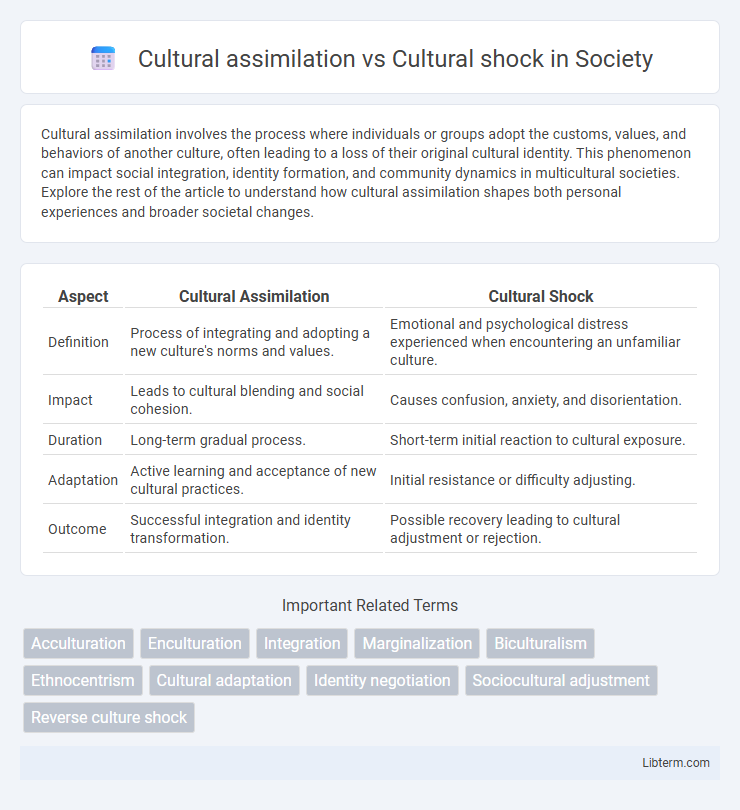Cultural assimilation involves the process where individuals or groups adopt the customs, values, and behaviors of another culture, often leading to a loss of their original cultural identity. This phenomenon can impact social integration, identity formation, and community dynamics in multicultural societies. Explore the rest of the article to understand how cultural assimilation shapes both personal experiences and broader societal changes.
Table of Comparison
| Aspect | Cultural Assimilation | Cultural Shock |
|---|---|---|
| Definition | Process of integrating and adopting a new culture's norms and values. | Emotional and psychological distress experienced when encountering an unfamiliar culture. |
| Impact | Leads to cultural blending and social cohesion. | Causes confusion, anxiety, and disorientation. |
| Duration | Long-term gradual process. | Short-term initial reaction to cultural exposure. |
| Adaptation | Active learning and acceptance of new cultural practices. | Initial resistance or difficulty adjusting. |
| Outcome | Successful integration and identity transformation. | Possible recovery leading to cultural adjustment or rejection. |
Introduction to Cultural Assimilation and Cultural Shock
Cultural assimilation involves the process where individuals or groups gradually adopt the cultural traits or social patterns of another group, leading to a blending or integration into the dominant culture. Cultural shock occurs when individuals experience anxiety, confusion, or disorientation due to exposure to an unfamiliar culture, typically during initial interactions or transitions. Understanding the dynamics of cultural assimilation and cultural shock is essential for navigating cross-cultural experiences and promoting effective intercultural communication.
Defining Cultural Assimilation
Cultural assimilation refers to the process by which individuals or groups adopt the cultural norms, values, behaviors, and language of another dominant culture, often leading to a loss of their original cultural identity. This process can occur through various means such as social integration, intermarriage, or education systems promoting the dominant culture. Understanding cultural assimilation is crucial in contrasting it with cultural shock, which involves the emotional and psychological discomfort experienced when encountering a new and unfamiliar culture.
Understanding Culture Shock
Culture shock is a psychological and emotional response experienced when individuals encounter a new and unfamiliar culture, leading to feelings of confusion, anxiety, and disorientation. It occurs in phases, typically starting with a honeymoon period, followed by frustration and adjustment stages, before reaching eventual adaptation or acceptance. Understanding culture shock is crucial for facilitating smoother cultural assimilation, where individuals gradually adopt new cultural norms while maintaining aspects of their original identity.
Key Differences Between Assimilation and Culture Shock
Cultural assimilation involves the gradual integration of an individual into a new culture by adopting its norms, values, and behaviors, leading to a sense of belonging and identity alignment. Cultural shock refers to the emotional and psychological distress experienced when encountering unfamiliar cultural practices and social environments, often resulting in feelings of confusion and anxiety. The key difference lies in assimilation being a long-term process of adaptation and acceptance, whereas culture shock is a temporary reaction to cultural dissonance upon initial exposure.
Stages of Cultural Assimilation
Cultural assimilation involves stages such as initial contact, honeymoon phase, crisis or culture shock, adjustment, and adaptation, where individuals gradually integrate into a new culture by learning its norms, values, and behaviors. The crisis stage, often termed culture shock, is marked by feelings of confusion, frustration, and anxiety due to differences in language, customs, and social expectations. Successful assimilation leads to cultural adaptation, enabling individuals to function effectively and develop a bicultural or multicultural identity.
Phases of Culture Shock
Culture shock typically progresses through four phases: honeymoon, characterized by excitement and fascination with the new culture; frustration, marked by confusion, anxiety, and irritability due to cultural differences; adjustment, where individuals gradually develop coping mechanisms and adapt to cultural norms; and mastery, achieved when one attains comfort and effective functioning within the new cultural environment. Cultural assimilation involves the deeper integration and adoption of the host culture's values and behaviors, often following the mastery phase, whereas culture shock primarily addresses the emotional and psychological process during initial cultural exposure. Understanding these phases aids in managing adaptation challenges and fostering smoother cultural transitions.
Psychological Impact: Assimilation vs Shock
Cultural assimilation often leads to a gradual psychological adjustment where individuals may experience identity transformation and reduced cultural stress as they adopt new social norms. In contrast, cultural shock triggers acute psychological distress, including anxiety, confusion, and feelings of alienation due to sudden exposure to unfamiliar cultural environments. The long-term impact of assimilation can promote psychological integration, whereas cultural shock requires coping mechanisms to prevent mental health challenges such as depression or social withdrawal.
Case Studies: Real-life Examples
Case studies on cultural assimilation reveal immigrant communities integrating language, customs, and social norms to achieve economic stability and social acceptance, such as the Japanese Brazilians adapting agricultural techniques in Sao Paulo. In contrast, cultural shock is documented in expatriates relocating to vastly different societies, exemplified by Western professionals in Middle Eastern countries experiencing disorientation due to divergent social etiquettes and religious practices. These real-life examples highlight how cultural adaptation strategies vary with the intensity of cultural differences and individual resilience.
Strategies to Manage Culture Shock
Strategies to manage culture shock include developing cultural intelligence by learning the local language and customs, which facilitates smoother social integration and reduces misunderstandings. Engaging in social support networks such as expat communities or local friendship groups provides emotional stability and practical advice. Maintaining flexible attitudes and practicing mindfulness can mitigate stress, helping individuals adapt more effectively to new cultural environments.
Promoting Healthy Cultural Integration
Promoting healthy cultural integration requires balancing cultural assimilation, which involves adopting the dominant culture's norms, with managing cultural shock, the emotional disorientation when encountering a new culture. Effective integration strategies include providing support systems such as cultural orientation programs, language training, and community engagement activities that respect diverse cultural identities. Fostering mutual respect and open communication between host communities and newcomers minimizes cultural shock and facilitates smoother assimilation.
Cultural assimilation Infographic

 libterm.com
libterm.com